Abstract
Using an induced-value experimental design that varies whether values for a “good” are certain or uncertain and whether payment is real or hypothetical, this study investigates issues of demand revelation, hypothetical bias, and value uncertainty for four elicitation mechanisms used in contingent valuation surveys: dichotomous choice, dichotomous choice with follow-up certainty question, payment card, and multiple-bounded discrete choice. For all elicitation mechanisms, we find no evidence of hypothetical bias: voting decisions do not vary systematically when payment is hypothetical versus when it is real. Under all design conditions we find the fewest deviations between stated and induced values and the strongest evidence of demand revelation with dichotomous choice. Stated uncertainty in dichotomous choice follow-up and multiple-bounded discrete choice questions does correlate with uncertain induced values, but the signal is noisy. We discuss the implications of our findings for the design of contingent valuation surveys.
Similar content being viewed by others
References
Becker G. M., DeGroot Morris H., Marschak J. (1964) Measuring Utility by a Single-Response Sequential Method. Behavioral Science 9:226–232
Berrens R. P., Jenkins-Smith H., Bohara A. K., Silva C. L. (2002) Further Investigation of Voluntary Contribution Contingent Valuation: Fair Share, Time of Contribution, and Respondent Uncertainty. Journal of Environmental Economics and Management 44:144–168
Burton, A. C., K. S. Carson, S. M. Chilton and W. George Hutchinson (2003). ‘An Experimental Investigation of Explanations for Inconsistencies in Responses to Second Offers in Double Referenda’, Journal of Environmental Economics and Management 46(3), 472–489
Champ P. A., Bishop R.C., Brown T. C., McCollum D. W. (1997) Using Donation Mechanisms to Value Nonuse Benefits from Public Goods. Journal of Environmental Economics and Management 33(2):151–162
Cherry T. L., Frykblom P., Shogren J. F., List J. A., Sullivan M. B. (2004) Laboratory Testbeds and Non-Market Valuation: The Case of Bidding Behavior in a Second-Price Auction with an Outside Option. Environmental and Resources Economics 29(3):285–294
Evans M. F., Flores N. E., Boyle K. J. (2003) Multiple Bounded Uncertainty Choice Data as Probabilistic Intentions. Land Economics 79(4):549–560
Gibbard A. (1973) Manipulation of Voting Schemes: A General Result. Econometrica 41(3):587–602
Holt C. A., Laury S. K. (2002) Risk Aversion and Incentive Effects. American Economic Review 92(5):1644–1655
Horowitz, J. K. (2005), The Becker–DeGroot–Marshak Mechanism is Not Always Incentive Compatible, Even for Non-Random Goods. Working paper, Department of Agricultural and Resource Economics, University of Maryland
Irwin J. R., McClelland G. H., McKee M., Schulze W. D., Norden N. E. (1998) Payoff Dominance vs. Cognitive Transparency in Decision Making. Economic Inquiry 36(2):272–285
Li C.-Z., Mattsson L. (1995) Discrete Choice under Preference Uncertainty: An Improved Structural Model for Contingent Valuation. Journal of Environmental Economics and Management 28:256–269
List J. A., Gallet C. A. (2001) What Experimental Protocol Influence Disparities Between Actual and Hypothetical Stated Values? Evidence from a Meta-Analysis. Environmental and Resource Economics 20(3):241–254
List J. A., Berrens R., Bohara A., Kerkvliet J. (2004) Examining the Role of Social Isolation in Stated Preferences. American Economic Review 94(3):741–752
Little J., Berrens R. (2004) Explaining Disparities between Actual and Hypothetical Stated Values: Further Investigation Using Meta-Analysis. Economics Bulletin 3(6):1–13
Messer, K. D., L. P. Gregory, W. D. Schulze, D. Rondeau and C. A. Vossler (2006), Exploring Voting Anomalies Using a Demand Revealing Random Price Voting Mechanism. Working Paper, Department of Applied Economics and Management, Cornell University, Ithaca, New York
Murphy J. J., P. Geoffrey Allen, Stevens T. H., Weatherhead D. (2005) A Meta-Analysis of Hypothetical Bias in Contingent Valuation. Environmental and Resource Economics 30(3):313–325
Murphy J. J., Stevens T. H. (2004) Contingent Valuation, Hypothetical Bias, and Experimental Economics. Agricultural and Resource Economics Review 33:182–192
Rabin M. (2000) Risk Aversion and Expected-Utility Theory: A Calibration Theorem. Econometrica 68(5):1281–1293
Satterthwaite M. (1975) Strategy-Proofness and Arrow Conditions: Existence and Correspondence Theorems for Voting Procedures and Welfare Functions. Journal of Economic Theory 10(2):187–217
Smith V. L., Walker J. M. (1993) Monetary Rewards and Decision Costs in Experimental Economics. Economic Inquiry 31(April):245–261
Taylor L. O., McKee M., Laury S. K., Cummings R. G. (2001) Induced-Value Tests of the Referendum Voting Mechanism. Economics Letters 71:61–65
Vossler C. A., Ethier R. G., Poe G. L., Welsh M. P. (2003) Payment Certainty in Discrete Choice Contingent Valuation Responses: Results from a Field Validity Test. Southern Economic Journal 69(4):886–902
Welsh M. P., Poe G. L. (1998) Elicitation Effects in Contingent Valuation: Comparisons to a Multiple Bounded Discrete Choice Approach. Journal of Environmental Economics and Management 36:170–185
Whittingto, D., V. K. smith, A. Okorafor, A. Okore, J. L. Liu and A. McPhail(1992) Giving Respondents Time to Think in Contingent Valuation Studies: A Developing Coluntry Application. Journal of Environmental Economics and Management 22(3):205–225
Acknowledgements
We thank Mary Evans, John List, Greg Poe and seminar participants at Georgia State University for their helpful comments and suggestions. We thank David Bruner and Zach Richards for their research assistance. Research supported by the J. Fred Holly Endowment.
Author information
Authors and Affiliations
Corresponding author
Rights and permissions
About this article
Cite this article
Vossler, C.A., McKee, M. Induced-Value Tests of Contingent Valuation Elicitation Mechanisms. Environ Resource Econ 35, 137–168 (2006). https://doi.org/10.1007/s10640-006-9011-5
Received:
Accepted:
Published:
Issue Date:
DOI: https://doi.org/10.1007/s10640-006-9011-5
Keywords
- contingent valuation
- demand revelation
- elicitation effects
- experiments
- hypothetical bias
- value uncertainty
- willingness to pay




